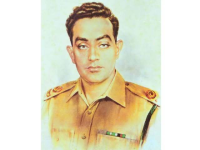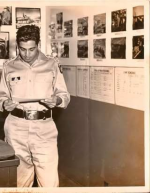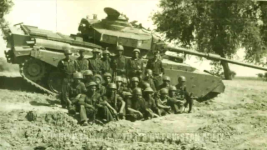1965 War:
Battle of Batapur
September 6, 1965
On this day India crossed the international border, unannounced and attacked Lahore. Credit goes to the Pakistan Army who not only repulsed the Indian attack but successfully defended Lahore. The entire nation in general and Laborites backed their Armed Forces against this naked aggression of Indians.
Today when our third generation is celebrating the “Defense Day”, while visiting Wahga border they notice war monuments along BRBL (Bambanwala-Ravi-Bedian Link) Canal and Grand Trunk Road and get curiously wonder about their history and background. One of these war monuments is located right in the middle of dual carriage GT Road on home side of BRBL, while driving along Lahore canal one hits the GT Road near Jallo Park and turns right towards Wahga where every evening the Flag lowering ceremony is witnessed by thousands of people from both sides of the border.
Background:
During early 1965 an indigenous uprising in Indian Held
Kashmir (IHK) against Indian occupation forces gained momentum. Based upon this accusation in August Indian forces launched attacks against Pakistan Army posts across the entire Cease Fire Line (CFL) and captured Hajipir Pass.
Pakistan Army launched its counter offensive in Chamb Sector which threatened Indian city of Akhnoor. Indians being under pressure from Freedom Fighters and Chamb offensive in IHK, violated international border and launched an attack against Lahore as their Army Commander General J N Chaudhuri declared to hold a Barakhana (feast for troops) in Shalimar Gardens and Grand Dinner with his officers at Gymkhana Lahore on 6 September 1965.
Indian Plan:
On 9 August General J.N Chaudhuri had finalized the plan to capture Lahore as he wanted to celebrate it at Shalimar Garden and Gymkhana Club and ordered Lt Gen Harbaksh Singh who was General Officer Commanding in Charge (GOC in C) Western Command to execute this plan with his 11 Corpse to capture Lahore as under: –
*15th Infantry Division: To attack Lahore across BRBL along GT Road (Amritsar- Wagha)
* 7th Infantry Division: To attack Lahore across BRBL along Kharla- Barki Road.
*4th Mountain Division: To attack Lahore along Khem Karan – Kasur Road.
Pakistan’s preparedness along the International border:
Pakistan’s Plan:
Pakistan had failed to visualize that Indians will violate the International Border and attack Lahore without declaration of war. However, in view of intelligence reports General Headquarters (GHQ) issued warning orders to its formation at 2230 hours on 4 September to occupy battle locations at Lahore Garrison despite request by Commander 114 Brigade to move to battle location along BRBL, he was not cleared, however, on night 5/6 September 114 Brigade was allowed to move forward. The Divisional Defense Plan was as under: –
*114 Brigade: To occupy defensive positions along BRBL starting from Ravi Syphon to GT Road.
*103 Brigade: To occupy defensive positions along BRBL from Barki Bridge to Bedian Head works.
*22 Brigade: As Divisional reserve force.
The Battle of Batapur:
On 6 September at 0400 hours by Indian Standard Time, 15 Infantry Division under World War 2 veteran Major General Nirinjan Parsad crossed international border and started advancing along GT Road towards Lahore. 15 Division was supported by 14 Scinde Horse, the tank regiment equipped with Sherman tanks. The attacking force was followed by 2 Independent Armored Brigade Group. On Pakistan side it was 3 Baloch (Shwebos) under command of Lt Col Tajammal Hussain Malik which started for BRBL canal. It was at 0600 hours that leading marching troops of 3 Baloch (Shwebos) started reaching banks of BRBL and saw GT Road jammed by villagers evacuating towards Lahore in face of advancing troops of Indian 54 Brigade. At that time there was only a one-way bridge on BRBL at Batapur which was clogged by refugees.
Commanding Officer 3 Baloch (Shwebos) could see Sherman tank of 14 Scinde Horse heading for this bridge. At the same time a bullock cart loaded with fodder also crossed over the bridge. Commanding officer immediately ordered one of his recoilless rifles to get hold of the cart and release the animals and deploy their rifle to take on advancing Indian Sherman tank. In the meantime, rest of the soldiers took positions in the open on home bank of BRBL and opened fire on advancing troops of 3 Jat Regiment of 54 Brigade.
As the Indian Advancing Sherman tank reached the bridge, the recoilless rifle of 3 Baloch (Shwebos) which had taken position behind the bullock cart fired its first round and Indian Sherman tank went into flames, thus blocking the bridge. It is pertinent to note that Pakistan Army did not blow up this bridge over BRBL as it served the main GT Road and all villages up to international border used to commute on it daily.
The battle for destruction of bridge by own troops and control of bridge continued till 13 September when Pioneer Platoon of 3 Baloch (Shwebos) was able to destroy it with improvised explosive devise by tying down anti-tank mines and blowing them off. The scene of destruction of Indian Sherman was later painted by Ms Anna Molka, the head of Department of Arts, Punjab University.
Role of PAF:
On 6 September two fighter jets of PAF were on armed reconnaissance at first light which was 0530 hours Pakistan Standard Time. These two Jets while over Wagha saw Indian tanks advancing along Amritsar –Lahore along GT Road and immediately took them on. The Indian advancing column proved sitting ducks for those fighters, while they emptied their guns on them the Indians ran for cover leaving their tanks and vehicles with engines running.
The Indian advancing Infantry met with a bloody nose as BRBL Canal proved a complete obstacle the Indian high command panicked as they could not fulfill the desire of their Army Commander to have a CHOTTA at Lahore Gymkhana in the evening.
Sacking of Major General Parsad:
Veteran of World War 2 got so desperate that on morning of 7 September he wanted to by- pass Batapur Bridge as brave soldiers of 3 Baloch (Shwebos) would not let him crossover and he wanted to please his Commander in Chief. Gen Parsad to explore breakthrough from Ravi Syphon/Bhini bridge side came forward himself and was ambushed by counter attacking force of 18 Baloch (3 Sindh now). He had to abandon his jeep and escaped on foot. It was not only Gen Parsad who was desperate to capture Lahore, his General officer Commanding in Chief Western Command Lt Gen Harbaksh was equally anxious. He along with Commander 11 Corpse visited Gen Parsad same day urging him to overrun BRBL and open the gates of Shalimar Garden and Lahore Gymkhana for Gen Chaudhuri, but Gen Parsad was so demoralized that he refused to continue operations.
Gen Harbaksh in his “War Dispatches” writes”, GOC 15 Division was drained of all will and vision……his attitude was passively negative and there was unmistakable air of the defeatist about him. He stated his inability to undertake any further offensive action on the plea that his formation has lost all capability of operations.” Gen Parsad was sacked and replaced by Maj Gen Mohinder Singh. Presence of General Officer Commanding in Chief Western Command, along with Commander 11 Corpse on the front line within the range of Field Artillery shows how serious Indians were for capture of Lahore and bellies their propaganda that their aim was to capture area up to BRBL Canal only.
The New GOC and fresh reinforcements:
With the change of command fresh reinforcements were sent to 3 Jat to capture Batapur Bridge and deny its destruction by 3 Baloch (Shwebos). The accurate fire by soldiers of 3 Baloch (Shwebos) did not allow Indians to reach near the bridge till 13 September when the Pioneer Platoon was able to make an Improvised Explosive Devise by making a necklace of anti-tank mines under the bridge and blowing them off along with bridge and any Indian evil designs of having BARAKHANA at Shalimar Garden and Grand Dinner Party in honour of Gen J N Chaudhuri at Lahore Gymkhana.
The Ceasefire:
Indians kept on banging their heads against BRBL Canal where they found every vigilant 3 Baloch Regiment (Shwebos) of Pakistan Army but every time they had to retreat leaving behind dead and wounded. In this sector 15 Division of Indian Army lost 486 soldiers whereas 39 soldiers of 3 Baloch (Shwebos) including one officer Capt Anwar Ul Haq embraced Shahdat. On 22 September the Security Council of United Nation passed a unanimous resolution for the ceasefire between both countries which came to effect at midnight 22/23 September 1965.
Later, President Field Marshall Mohammad Ayub Khan and Indian Prime Minister Lal Bhahdur Shastri signed an agreement known as Tashkent Declaration to withdraw their forces to pre-August lines by 25 February 1966




















